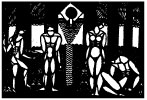| |
In his play Contemporaries, Steele used an event well-known to the Villagers as a context to make a serious statement about the trial and eventual imprisonment of a young IWW leader, Frank Tannenbaum. In 1914, during one of New York’s most bitter and coldest winters, Tannenbaum, a twenty-one year old bus boy, had led unemployed workers into a number of New York City churches demanding food and shelter. He was arrested when a priest worked with police to trap him and 189 of those who went with him to St. Alphonsus Church. After an impassioned speech to a crowd of unemployed workers in Rutgers Square that night, Tannenbaum had warned his followers that the commercial press, hostile to their actions, had incited the police against them. Father Schnieder refused to feed and house Tannenbaum and his followers that night and Tannenbaum directed the crowd to leave the church quietly, but they were soon met by police. Though a reporter from the New York Tribune testified in court that there had been no disorderly conduct in the church, Tannenbaum was charged with inciting to riot and sentenced to a year in prison. Mabel Dodge attracted notice for attending the trial with Hutchins Hapgood and received headlines in the papers for her support of the IWW and the unemployed; she wrote an article on the trial for The International magazine.
With their commitment to the IWW, Mary Vorse and Joe O’Brien had been at the center of the crisis, using their apartment in the Village as something of a headquarters for those participating and O’Brien was of Tannenbaum’s legal defense team. A year later, Vorse wrote Steele when Tannenbaum was finally released from prison, telling how she and O’Brien were there to retrieve him amongst a crowd of reporters and photographers.(1) IWW leader Joseph O’Carroll(2) had told those who were arrested, “Jesus Christ was a hobo. He, too, was arrested and persecuted as we have been. I tell you we unemployed men here tonight are 20th Century replicas of Jesus Christ.” The Masses devoted a lot of space to the incident, including drawings that connected the teachings of Jesus with anarchist principles and Art Young drew for the cover of their December 1914 issue a scene of Jesus as a carpenter who cared for the working man’s cause.(3) Contemporaries ultimately likens Tannenbaum to a modern-day Jesus, but saves that revelation until the end, when a change in lighting reveals the characters dressed in biblical garb, “ironically equating the trials of early Christianity with those of contemporary radicalism.”(4) Though this association of Jesus with Tannenbaum was not original to Steele, who was himself the son of a minister, he finds an interesting theatrical device to present this idea. Comparing it to the thematic strategy of O. Henry’s or Steele’s own short stories, Murphy describes that the play “uses sentiment to attach the audience’s sympathy to some characters and alienate it from others, and then makes use of an ironic twist to convey its didactic message.”(5) In Contemporaries, the “twist” is visual, relying on a very dimly lit stage to hide all but the faces of the characters until it is revealed toward the end by a fully-illuminated stage that their clothing and the set are in Jerusalem during New Testament times, not New York in 1914 as it originally seems.
That first “season” of Summer 1915 that staged four plays had ended with a serious and unique play inspired by a decidedly political event and with didactic purpose, unlike the three plays that preceded it. Deutch and Hanau, who describe the play incorrectly but more fully than the other three original plays, call it “profoundly moving,” and that, given the political activism of many of the Villagers, “it was natural that social justice should be an issue.”(6) Sarlos reports, based on interviews with Rauh and Vorse, that the cast included Cook as the Father, Rauh as the Mother, Eastman as the Lodger, Robert Emmons Rogers as the Priest, and Vorse’s son Heaton as Sam; no one is mentioned for the role of Old John. There is a moment in the play when lights are supposed to pass by a window at the back of the stage, which was where the sliding door was open to the bay, and James Light recalled to Sarlos that the story often told was that Louis Ell had to sneak behind the window with a candle and, in doing so, fell into the water off the wharf.(7)
© Jeff Kennedy 2007
(2)
O’Carroll was art of the group in the summer of 1914 in Provincetown that reacted so wildly to new of the war in Europe.
(3) Murphy, Provincetown2/28.
(5)
Murphy, Provincetown2/29.
|
